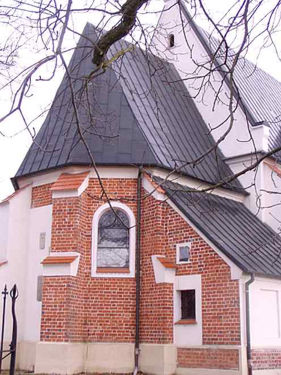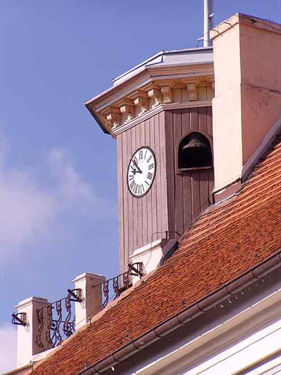The Cistercian Trail – Tourist Route
The Cistercian Trail is a tourist route that highlights the historical connections between the Cistercian Abbey in Ląd on the Warta River and numerous towns in the present-day Konin district. According to the preliminary project, this route is also part of the broader "Route to Malbork," specifically the German route, showcasing the cultural heritage of Poland's western neighbors in Wielkopolska.
The European cultural heritage linked to the Cistercian order, founded in the 12th century, reveals its economic, political, and cultural influence in the region of the former Lędzko chatelaine (Lędzko-Konin land), which later became the historical Konin district.
The "Grey Monks" who settled in Ląd on the Warta played a pivotal role in integrating Christian Europe. They introduced many innovations to the Slavic lands, including advancements in agricultural practices, fruit cultivation, fish farming, and construction, particularly Gothic architecture. They also taught the use of various energy sources, such as water and windmills.
Arriving in Poland in 1145, the Cistercians quickly earned the trust of the Piast princes of Wielkopolska, who often leveraged their extensive European connections for political purposes. The monks of Ląd loyally served Władysław the Short, Casimir the Great, Władysław Jagiełło, and other monarchs. They also gained the respect of the 13th-15th century gentry and clergy. Through numerous legacies, the Abbey in Ląd became one of the largest landowners in Wielkopolska, controlling three towns in the 16th century and many villages across the former Gniezno, Pyzdry, and Konin districts, as well as in Dobrzyń and Gdańsk Pomerania. The abbey owned properties in several cities, including Gniezno, Konin, Pyzdry, Poznań, and Gdańsk.
The Cistercians' relationships with the Grand Teutonic Masters, Polish kings, German emperors, and the great metropolis of Cologne, provided them with significant social, political, and economic influence. Over the centuries, they built one of the largest monastic estates in Wielkopolska, investing large sums earned from agriculture into works of art. The monks of Ląd also maintained a substantial library of over 5,000 volumes. Their political power was secured through their connections with the court of the Piast princes of Wielkopolska, who were their patrons. During the reigns of Władysław the Short, Casimir the Great, and Władysław Jagiełło, the monks assisted in diplomatic efforts. The abbey was a venue for princely conventions, the signing of political treaties, and the consecration of newly elected bishops. Ląd monks served the Grand Teutonic Masters and played a role in securing peace treaties signed by Polish kings.
Economically, the Cistercians exerted influence through capital investments. They competed with the collegiate church of the Blessed Virgin Mary in Kalisz and various cathedral chapters. The monks invested in mills, butcher's shops, and other enterprises in the cities where they had deposits.
Over centuries, the Cistercians cooperated with the bishops of Poznań and the cathedral chapter of the capital city of Wielkopolska. They were honored as monks in the Gniezno chamber and sometimes served as vicars for the archbishop. The monks established parishes in towns and villages within their sphere of influence. The legacy of the Cistercians from Ląd can still be seen in the extensive network of monuments located throughout the modern districts of Konin, Gniezno, Kalisz, Poznań, and beyond.
The former abbey in Ląd remains a testament to their influence on Polish national culture, rich in European elements. Many of these elements can still be found in the present Konin district. For instance, Gosławice (now part of Konin), once a village belonging to the Zarembów family, was a consistent beneficiary of the abbey's patronage in the 14th-15th centuries. The Cistercians of Ląd maintained close ties with the Bernardine monks in Kazimierz Biskupi, the Camaldolese brothers in Bieniszew, and even the Reformers in Konin.
Over the centuries, the Cistercians held several towns as either their property or as deposits, including Chorzeń, Czeszewo, Kazimierz Biskupi, Królików, Lubomyśl, Rzgów, Sławęcin, Sławsk, Starołęka, and Święcia. They benefited from rents, tithes, and other obligations levied from many other towns. The Cistercians also maintained close relationships with the collegiate church of the Blessed Virgin Mary in Kalisz and the cathedral chapters in Gniezno and Poznań. The clock on the town hall in Konin, brought here in the 19th century after the dissolution of the order, serves as a significant symbol of the Cistercian monks of Ląd.
The abbey in Ołobok, home to Cistercian nuns, is also featured on the trail. From there, the route leads through Kalisz, where the Collegiate Church of the Blessed Virgin Mary—founded in the mid-14th century—became a central point where Polish-German relations intersected. This church succeeded the older St. Paul’s Collegiate Church, where the body of Prince Mieszko III the Old, founder of the Ląd Abbey, was buried. From Kalisz, the route continues through Rychwał, Grodziec, Królików, Kowalewek, Rzgów, and other locations before reaching the Ląd Monastery. The Konin section of the route continues through Golina, Kawnice, Bieniszew, Kazimierz Biskupi, Gosławice, and beyond to the Pomeranian estates of Kłodawa, Trąbki Wielkie, and Godziszew, marking key sites of the Kłodawa-Godziszew provostry. The trail culminates in Gdańsk-Oliwa.
Ląd, one of the three colonial Cistercian abbeys in Wielkopolska, was founded by a convent primarily composed of sons of Cologne townspeople. From the mid-13th century to the mid-16th century, these townsmen were the only men accepted into the abbey. However, by the 16th century, national conflicts forced the Cologne townspeople to leave Ląd and relocate to Silesian monasteries in Henryków, Kamieniec, Krzeszów, and Lubiąż.
As servants of the Grand Teutonic Masters, the Cistercians played an active role in Polish political life, providing valuable services to Władysław the Short, Casimir the Great, Władysław Jagiełło, Casimir Jagiellonian, and others. During the 1339 Warsaw Process, they testified against the Teutonic Order.
The immense influence of the Cistercian Order on the economy and culture over the centuries is worth preserving through the presentation of the monuments along the Cistercian Route, which forms a part of a larger cultural pilgrimage. Thanks to the Cistercians from Cologne, several religious cults were introduced to Wielkopolska, including the cults of St. Ursula (in Wilczyn), the Three Kings, and St. James. The Abbey in Ląd was a major center of devotion to St. James the Apostle, and it played an essential role in the development of the Polish pilgrimage route to Santiago de Compostela in Spain. Numerous churches dedicated to St. James, associated with the Ląd Abbey, point to the existence of this Polish route to Santiago.
Prepared by: Paulina Wojtyniak









